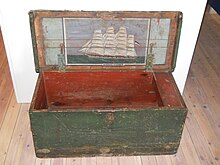Sea chest


The sea chest (also ship 's chest or sailor 's chest, English: sea locker; locker seat; seaman's chest; Dutch: zeekist) was a wooden box for the personal belongings of the sailor, which was used in place of a suitcase or similar transport and storage utensil .
Terms
At the end of the 18th century, Röding used various English terms for this piece of furniture: “sea chest”, “sea locker”, “locker seat” or “sailors chest”. It is a specialization of Engl. “Chest” for box . Röding explains this under the heading “loose” as: “A back or basket nailed against the inner side of the ship, for various uses.” This explains “locker seat” for seat box and “sea locker” for sea box . This means that the individual uses of the sea chest are named in the English language. On the one hand the seating and on the other hand the possibility of locking and protection against unauthorized access. Laymen also use the term seaman's chest .
use
It served in the logis , the living room of the ship's crew, as a bench and as a container for the sailor's personal belongings. For decoration and as a personal touch, the sea chest was usually decorated with painting, more rarely with carvings and pyrography. The size and proportions of the box do not vary much, as there was limited space everywhere on board. However, there are differences between the sea chest of a captain and that of an ordinary seaman. Usually two parallel scantlings, similar to runners, are mounted under the floor so that it is not damaged when sliding and you still get some height against the moisture on the deck or the ground (for example in the bilge). The sides are rarely vertical, rather inclined slightly upwards inwards. This lowers the center of gravity and the box is less likely to tip over. The lid protrudes over the walls and is made as a seat. There is always a lock, as well as at least two handles on the two short sides. Mostly these are made of rope, often made as fancywork .
Little is known about the contents of sea crates. Only in Robert Louis Stevenson's Treasure Island is the contents of a sea chest looted. There is at least one small compartment for smaller items. It can often be found on the right-hand side, but there are also known examples that have this compartment over the entire length.
Sea chests of uniform size and fittings were made for the Imperial Navy ; They were primarily used by officers to transport equipment and personal items. For the crew ranks there is the duffel bag , which is still in use today.
Trivia
The term is used repeatedly as a catchphrase in marketing. Examples:
- Peter-Michael Luserke: Thirteen stories from the sea chest . Salobreña 2004. ISBN 84-96083-34-9 . (for maritime stories from the personal area)
- Die Seekiste, the journal der Schiffahrt , was published by Koehler in Herford from 1949 to 1969 (for a journal with a decidedly informal intention without a scientific background)
literature
- Konrad Reich , Martin Pagel: Heavenly broom over white dogs. Sailor's language in words and pictures . transpress VEB publishing house for transport, Berlin 1981.
- Peter Barrot: Sea boxes. Multipurpose sailors' furniture. A contribution to the social history of seafaring . Bremen 2011, ISBN 978-3-89757-483-0 .
Web links
Individual evidence
- ↑ Key point sea box in Eduard Bobrik: General nautical dictionary, with explanations: German, English, French, Spanish, Portuguese, Italian, Swedish, Danish, Dutch . Leipzig 1850, p. 391
- ^ Johann Hinrich Röding: General dictionary of the navy in all European sea languages with complete explanations . Nemnich, Hamburg & JJ Gebauer, Halle, 1793–1798; here Volume III, p. 87 of the English-German index; Fig no. 614 of the panel part; In traditional cargo shipping, a separate, easily lockable, smaller part of a hold for particularly valuable goods is referred to as a locker .
- ↑ Chapter 4 of Treasure Island engl.